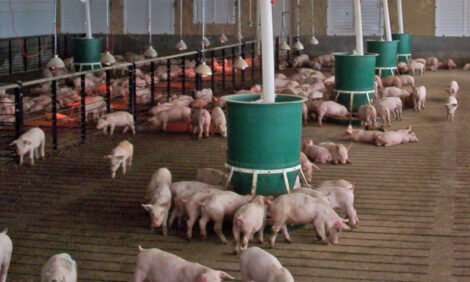



Hong Kong Pork Industry Overview, August 2004
By USDA Foreign Agricultural Service - This article provides the pork industry data from the USDA FAS Livestock and Products Annual 2004 report for Hong Kong. A link to the full report is also provided. The full report include all the tabular data which we have omitted from this article.Report Highlights
Hong Kong’s ban on U.S. beef products led to a loss of approximately $55 million, in terms of
export value, during the past eight months. Hong Kong consumers have not reacted
negatively to the BSE case in the U.S. but beef supplies from other countries have now taken
over the U.S. market share. Many industry professionals feel that it will be a challenge for
the U.S. to regain its previous market share after Hong Kong re-opens its market to U.S.
beef.
Both beef and pork consumption are forecast to rise in 2004, particularly pork, due to
the substitution effect resulting from the shortage of chicken. Hong Kong’s pork imports are expected to rise in 2004 due not only to the substitution effect but also to escalating prices. Traders have a big
incentive to increase their pork imports when they expect prices will continue to rise in the
near future.
Pork imports for 2004 is forecast to rise 5 percent. The estimated growth is based on two
factors. First, the substitution effect of chicken products as explained earlier. Secondly, pork
prices have been very high and importers are expecting high prices will continue into the
second half of the year. Therefore, buyers have a big incentive to stock up so as to reduce
loss due to ever escalating costs.
The import of U.S. pork to Hong Kong rose tremendously in the first half of 2004. The
lowering of average U.S. pork prices by 7 percent (table 16) has certainly helped the growth.
In addition, more pork menu have been promoted in the absence of U.S. beef. Nonetheless,
U.S. pork is relatively expensive and its consumption is limited to very high-end restaurants
and hotels.
Narrative on Supply and Demand, Policy & Marketing
There has not been any significant change in production since the last report.
The number of live pigs imported from China increased almost 7 percent between January –
May 2003 and 2004. The increased demand for pork has been ascribed to the short supply
of chicken resulting from Hong Kong’s temporary ban on chicken imports from China in early
2004. The ban was imposed as a result of the avian influenza outbreak in China. Presently,
the Hong Kong government is still restricting the number of live chicken imports from China
to around 30,000 head daily, when the normal demand used to be around 100,000 head
each day. The reduced supply of live chicken has pushed up the demand for pork indirectly.
There is no indication that the Hong Kong government will lift the quantity restriction on
chicken imports, hence, the forecast for pork production will rise to 148,000 MT in 2004,
representing a 2 percent rise from 2003.
Reverting the trend of ever decreasing wholesale prices of pig in previous years, prices have
picked up in the past few months. The major reason is that China has experienced high feed
prices leading to high pig prices for exports. Also, chilled pork imports from Thailand, which
have been an acute competitor of fresh pork in the market, have dropped significantly by 59
percent between January – May 2003 and January - May 2004.
Local supplies account for approximately 23 percent of total supply. Despite the rise of
wholesale prices of pigs in the past months, local production will not rise due to capacity
limitation. Farmers generally do not see the pig production industry in Hong Kong as
promising, thus they do not have any incentive in making big investment in their businesses.
The fresh pork industry is expecting huge competition with chilled pork imports from China.
Currently, chilled pork imports are not allowed into Hong Kong. The Hong Kong government
has been working on an import protocol with the Mainland Chinese authority with regard to
the importation of chilled pork from China. Initially the importation was planned to start in
summer 2004. It did not materialize by then and is expected to take place next year.
Chilled pork is likely to have more competitive pricing thus would impose a big threat to the
fresh pork industry.
In the first three months of 2004, there were 4 cases of foot and mouth disease in Hong
Kong involving 742 pigs and 1 case of classical swine fever with 300 pigs infected.
Pork Trade
Due to the ban of U.S. beef, many restaurants are promoting more pork or lamb dishes. This
is one major reason leading to the significant jump of U.S. pork to Hong Kong (70 percent
between January - May 2003 and 2004) (table 14). U.S. chilled pork in particular recorded
190 percent rise in volume compared between the first five mo nths of 2003 and 2004 (table 21). U.S. chilled pork has a very niche market by supplying to extremely high-end
restaurants and supermarkets as prices in general are too expensive for ordinary
restaurants. Popular cuts include filet and pork loin. Nonetheless, the average prices of U.S.
pork dropped 7 percent between January – May 2003 and January – May 2004. This was
another reason that contributed to the significant jump of U.S. pork exports to Hong Kong in
the past few months.
Hong Kong’s economy has gradually picked up since late 2003. The catering industry has
benefited from the buoyant inbound tourism largely spearheaded by tourists coming from
Mainland China. When coupled with the fact that the importation of live chickens from China
is not yet up to normal and U.S. beef is still banned, Hong Kong’s pork imports (excluding reexports)
may rise 5 percent for 2004 reaching a level of 317,000 MT.
However, another major reason that supports the 5 percent growth of pork in 2004 is the
high pork prices. In 2004, pork prices from China have risen due to rising prices of feeds
and strong pork demand in China. Hong Kong traders have also faced high prices from pork
supplied by other countries including Brazil. The strong demand for pork in the Russian
market has pushed up pork prices. Hong Kong traders tend to buy more and increase their
stock as they expect prices will continue to rise. Therefore, the forecast of 5 percent growth
in 2004 is based on the substitution effect between different meat products, a better
economy and the expectation of rising pork prices.
To view the full report, please click here (PDF)
Source: USDA Foreign Agricultural Service - August 2004








